The world of Swiss Army knives is vast, and I couldn’t hope to adequately cover
the topic in the small amount of space I have here. Further, I am not in any
way, shape, or form, an expert in the field. I am an enthusiastic Swiss
Army knife owner however. I’ve had quite a number of them over the years. I bet
that you’ve owned more than a few yourself. I’ve noticed that somehow, SAKs
have a way of just ending up in your possession, regardless of whether or not
you’ve actually tried to seek them out.
When I decided to write about Swiss Army knives, I ransacked the house to try
to gather up as many as I could find. Then, while refreshing my knowledge
about them, I decided that I needed to get at least one new one, just to be
up to date, you know  .
.
The number of different types of Swiss Army knives is vast, so to try to organize
this a little bit, I’m going to break up the discussion into sizes small, medium,
and large. And I’m only going to talk about the knives that I have. There are
so many out there that I’ve never put my hands on.
But first let’s talk about Victorinox, the only company now making real Swiss
Army knives. Sure, there are other companies making Swiss army-type knives, but
Victorinox is the only company legally entitled to use the name Swiss Army knife.
You may ask, “But what about Wenger?” That’s right, Wenger used to be the only
other company supplying knives to the Swiss Army. They were also legally entitled
to use the term Swiss Army knife. Wenger was purchased by Victorinox in 2005.
The Wenger name lives on as a brand of Victorinox, but since 2013, all Wenger SAKs
are now branded as Victorinox. The former Wenger Swiss Army knives are now known
as the Victorinox Delémont Collection. Delémont is the French Swiss city where the
Wenger headquarters is located. There have been some small changes to the Wenger
knives since Victorinox took them over, and some models have been dropped.
From SAKWiki.com:
In 1884, Karl Elsener started his cutlery business in Ibach Switzerland. Soon after
he approached the Swiss government about supplying the Swiss army with knives
manufactured in Switzerland, rather than importing them from Germany. In 1891
Elsener's Cutlery as a member of an association of Swiss cutlers, started supplying
knives for the Swiss army.
In 1909, in part to distinguish his knives from competition, Elsener started putting
the Swiss Cross on all his knives. It was also in this year that Elsener named his
company Victoria after his mother, who had just passed away. Twelve years later,
after Stainless Steel is invented, Elsener added the suffix inox, from the French
word inoxydable (meaning stainless) to the name and renamed the company Victorinox.
Stainless steel was a significant historical achievement, and was also noted for
many years on the tang-stamp of the main blade with the German word rostfrei.
There have been four basic multipurpose folding knife designs that have been
official Swiss Army soldier knives, issued to Swiss troops. The original was
issued in 1891 and lasted to 1951. The 1951 redesign was the shortest-lived
version, lasting only to 1960. In 1961 a new design was issued that featured
waffle-pattern aluminum scales. That one lasted up to the year 2008, when the
current Soldier knife was introduced.
I have one SAK that is very similar to the 1961 Soldier knife, and another which
is like the current Soldier knife. Both I own are commercial versions, and I’ll
talk more about them when we get there. So now let’s get on to the knives.
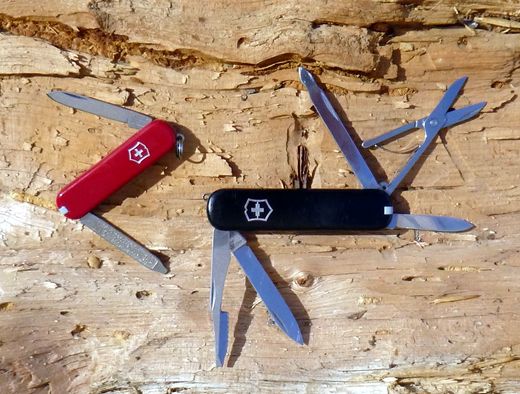
Left, Escort (58mm); right, Executive (74mm)
|
Small
The very small Escort model is a
great example of what I was saying earlier. I have no idea of when, where, or
how I got that knife. It was probably a promotional give-away for something.
It has only two blades in a single layer, a pen-knife blade and a nail file.
It does have the toothpick and the tweezers though. The Escort is apparently
a rarity. This keychain size knife (58mm) is the smallest size of SAK. The
model seen most often in this size is the Classic, which is a two layer knife
that adds scissors to this tool set. The Escort has been in a drawer in my
house for many years and sees no use whatsoever. Back to the drawer now …
The Executive is a totally different
story. Long before the term EDC (every day carry) became a fashionable term of
art, I have referred to this as my “every day knife”. I was never hip enough to
shorten that to EDK. I have carried one of these on a small belt sheath on my
side every day for all of my adult life. I can’t even tell you when I started
carrying it, but I’m sure that it is in excess of 30 years. Reaching for it
is pure muscle memory at this point.
This 74mm size (2.9 inches) is not a common SAK size. It’s in between the keychain
size (58mm), and the standard pocket knife size (91mm). As an office worker, I am
very comfortable carrying this on a daily basis.
The Executive has a large pen knife blade and a small one. It’s got a nail file
and scissors. The most unusual implement on it is the orange peeler. There is a
small flat head screwdriver on the tip of the orange peeler blade. The orange
peeler is exclusive to the Executive.
In that 30-plus years of carry, I’ve only lost my knife once. After a week spent
without it, I got antsy and placed an order for a replacement. All was right with
the world when I once again had the Executive on my hip.
I very rarely use the orange peeler for its intended purpose. I have used the
little screwdriver on the end a lot. It works great for loosening or tightening
the little screws on computer cable connectors.
The pointed tip on the end of the nail file works to tighten and loosen small
Phillips screws. The large blade is used to open boxes by cutting the tape. The
little blade, the scissors, and the nail file keep my nails pretty  .
I’ve also used the pointed ends of the file and the orange peeler to pry recalcitrant
rounds out of the chambers of various firearms.
.
I’ve also used the pointed ends of the file and the orange peeler to pry recalcitrant
rounds out of the chambers of various firearms.
In my everyday life, situations that require the use of a blade bigger than the
ones in my Executive are rare. But now that I’m reviewing my blade choices, I’m
starting to think, “Who says that you’re limited to just one EDK?”
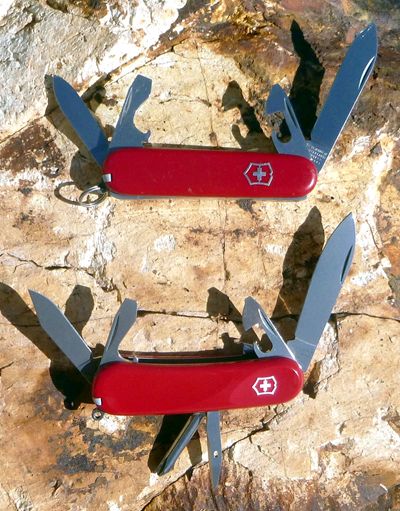
Top, Recruit; below, Evolution S111
|
Medium
This size class of SAK is what first pops into your head when you think of the Swiss
Army knife. The closed length of these SAKs ranges from 84mm to 93mm. this size
encompasses the greatest number of models.
I have four to share with you, that take us from basic to moderately full featured.
Let’s start with the Recruit.
I mentioned to my son Sam that I was doing this article and that I had been rounding
up all the SAKs I could find. He told me that he had one in his camouflage hunting
pack. I was able to identify it as a Recruit. Sam says,
“I think I originally got one from you as my hunting/ camping/ outdoors knife. I
ended up losing that one, likely at a scout function, and proceeded to buy a new one,
for that was the only knife that I knew. Due to the nature of its non-locking blade
I have cut my hands open quite a number of times with it, and have scars to show from
that. Other than that, I kept it in my backpack so that I would never have to
remember to put a knife into my bag whenever we left on camping trips. The largest
downside is the thin blade and the fact that the blade does not lock.”
The Recruit is a compact 84mm model with large and small knife blades. It also
has a bottle cap lifter with large screwdriver, and the can opener blade with the
small screwdriver. Like most Swiss Army knives, it also includes tweezers and
toothpick in the handle scales.
Next up is the new knife that I bought just because I was writing this story, and
I had not bought a new Swiss Army knife in a while. This one is the
Evolution S111. Notice that this
one is not named after some kind of a person. That’s because this one was not
originally a Victorinox. This is one those knives from the Delémont Collection,
a former Wenger knife. This is my first Wenger.
By comparison with the Recruit, you can see that it is basically an expansion of
that knife with the addition of two back layer tools, a Phillips screwdriver and
an awl. The standard Wenger knife size is 85mm, which is a bit smaller than the
standard Victorinox at 91mm. The 91mm Victorinox Tinker has the equivalent tool
set as the S111.
Because this is a Wenger, there are a couple of interesting differences in this
knife if you are used to Victorinox knives. The first major difference is
something that Sam mentioned: the large blade locks in the open position. I’ve
never seen a locking blade on any Victorinox in this size class, but as I said,
I’m not an expert.
It’s hard to see in the photo, but the blade locking lever sits in the shadow
of the can opener blade. You push it down to unlock the blade. Then there is
a half-closed position that catches the blade, allowing you to get your fingers
out of the way before you push the blade all the way down to close it. That’s
a nice safety feature.
Exclusive to the Wengers is the small clip point blade. Compare that to the
standard Victorinox small blade on the Recruit on which the back of the point
is rounded.
The Evo S111 also features Wenger’s ergonomic handle scales. This may also be
difficult to see in the photo, but the scales are contoured. There is a nice
little dish-out near the base of the large blade which gives a nice place for
your thumb to rest. The dish-out on the opposite side feels good to your index
finger when holding the knife in a pinch grip.
While Victorinox stayed with the Wenger caplifter/large screwdriver blade,
they replaced the Wenger can opener blade with the standard Victorinox version.
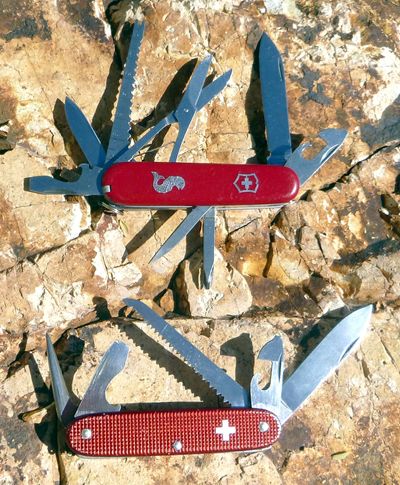
Top, Fisherman; below, Farmer
|
Next I’d like to talk about the
Farmer. Right off the bat, you can see what’s different about this
one. Instead of smooth plastic scales, it has waffle pattern aluminum scales.
Victorinox refers to these scales as Alox, which I presume means aluminum
oxide. The Farmer is a commercial derivative of the 1961 pattern Soldier
knife. The direct commercial relative of the Soldier knife is the Pioneer
model. The Farmer differs from the Pioneer and the Soldier’s knife by the
addition of the saw blade.
SAK geeks might recognize that this one is a little special. It’s an early,
original Farmer. First it has red Alox scales. Second it does not have the
typical Victorinox shield. Instead it has a simple Swiss cross. Third, the
layer spacers are not aluminum, rather they are brass. Current standard
production Farmers have silver Alox handles, aluminum spacers, and exhibit
the Victorinox shield.
I bought it new, many years ago. I don’t remember when or where, but I do
remember seeing it and deciding right away that it had to come home with me.
The metal handles just made it look so much cooler than the typical SAK.
But here’s a funny thing. For a long time I didn’t even realize that it had
a saw! The saw sits right in the middle of the knife and I thought that it
was just a divider. But one day I was rolling it around in my hand and I
put a fingernail under the tip of the “divider.” It lifted up to reveal a
blade that I didn’t even know I had. It was a wonderful surprise.
The toolset is particularly well suited for outdoor pursuits. You only need
one good cutting blade. The Farmer’s is a bit thicker than the normal SAK
blade. Screwdrivers, bottle lifter and can opener are common, but it also
has the saw and an awl with a sharpened right angle folded side edge which
makes it a great improvised drill. Notice that the Farmer does NOT include
the tweezers and toothpick. That is common to all Alox handled SAKs.
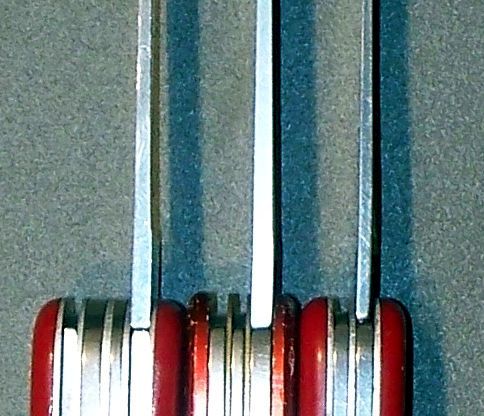
Blade thickness: Fisherman, Farmer, Recruit
|
For a long time, the Farmer always accompanied me in my outdoor pursuits.
I’ve used the saw a number of times to clear shooting lanes and to saw
through the pelvic bones of downed game. The saw exhibits the scratch marks
of honest use. Silver is showing through in a few places on the aluminum
scales. Now it’s sort of unofficially retired from the woods. It remains
a treasured favorite though.
The final medium sized SAK that I have to talk about is the
Fisherman. This one came
to me because it used to be my Dad’s. When he passed, his knife passed
to me. He was pretty big on fishing. I don’t fish much these days, but
when I do, this knife comes with me to bring his presence.
A number of years ago, I was fishing on the shore at Big Lake in the White
Mountains. I had pulled it out of my tackle box to trim some line using the
scissors. It came time to try another spot. After about 20 to 30 minutes
at the new spot, I realized that the knife was not in my tackle box. There
was only one place it could be. I must have left it on the ground where I
last used it!
So I rushed over there to try to find it. I found somebody else there at
my former spot. After looking around for a minute, I asked the guy whether
he had seen a Swiss Army knife around here. The look on his face told me.
He slowly and reluctantly reached into his pocket and stretched out his
palm with the knife in it. Thanks! Whew!
The Fisherman builds further on the Recruit and the S111 or Tinker, by
adding a hook disgorger/scaler/ruler tool, and a nice pair of scissors.
Yes, I have used the hook disgorger for that purpose. You pull on the
line to tighten the hook against the tool, then you push and twist to
free the hook.
It’s not a huge knife, but by the time you get up to this number of
devices, you need four layers. The length of the Fisherman is 91mm.
The Fisherman, and the related Angler can be identified by the little
squirming fish inlaid on the front scale.
Large
I have two 111mm Victorinox SAKs. Well, actually three, but I’ll get to
that in a minute. All 111mm SAKs feature locking blades. These are the
latest design, and in my opinion, are a nice improvement over the classic
knives.
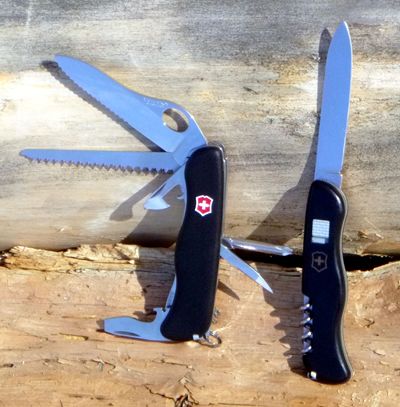
Left, One-Handed Trekker; right, Alpineer
|
My first one of these was the single-bladed
Alpineer. This was another
one of those knives that I didn’t seek out, it sought me out. It was a
promotional knife that was included when I purchased a Simmons rifle
scope back in the 1990s. The word Simmons and the round Simmons logo
were silk screened on the back, but this has long ago rubbed off.
I almost threw this one away. When I received the scope, I took it out
of its shipping box and promptly tossed the packing into the recycling
trash. Later I was reviewing the invoice and noticed that there was a
line there for the free promotional Swiss Army knife. I headed outside
to the trash can and lo and behold, there buried in the packing paper
was the knife! Score!
The standard Alpineer comes with red scales. Only this promotional
version came with black scales. The Alpineer features a grey slide
lock button. It’s a little stiff to operate, but it locks very well.
The standard Alpineer exhibits the Victorinox shield on the side
opposite the locking button. On mine, the shield is on the button side.
This one is a favorite home office desk drawer knife, not an outdoor
knife for me. Somehow, this is my only SAK with a corkscrew, as common
as that silly thing is.
Just like what happened when I first laid eyes on the Farmer, the same
thing happened when I saw the
One-Handed Trekker (or OHT) under a glass counter at a sporting
goods store. I had to take it home. And that is the reason that the
Farmer has gone into retirement. The OHT is now my go-to multi-purpose
tool for outdoor pursuits.
And like the Farmer is a derivative of the 1961 Soldier’s knife, the
OHT is derived from the new (in 2003) 111mm German Army Knife. The
OHT was introduced in that year as a civilian version of the GAK. In
2008, this design was also selected as the new Swiss Soldier’s knife,
replacing the Alox handled 1961 Soldier’s knife. The only difference
in the civilian version to the military versions is the addition of the
tweezers and toothpick, and the black instead of olive drab scales.
The toolset is exactly the same.
If you compare the features of the OHT to the Farmer, you will see that
the OHT is everything that the Farmer is and more. The OHT has a saw
and a bigger main blade that is serrated. The main blade locks (liner
lock, not a slide lock), and so does the large screwdriver/caplifter.
Plus the OHT adds a Phillips screwdriver. The blade on the OHT has a
large hole that allows the blade to be opened one-handed, hence the
name. The blade cannot be snapped open with one hand. There’s a fair
amount of side plate tension and you have to reposition your hand to
get it fully open, but the movement is smooth due to the polished surfaces.
Oh yeah, I mentioned that I own three 111mm SAKs. I once misplaced my
OHT. After several months of nowhere-to-be-found, I placed an order
for a new one. When the next hunting season rolled around, I found my
lost OHT at the bottom of a hunting equipment box. So now I have two.
By the way, that awesome-sharp serrated blade makes a great tomato and
onion slicer for camp burgers, not to mention a good mayonnaise spreader.
I started off by saying that I am not any kind of a Swiss Army Knife
expert. I know that I’ve put a lot of info into this story that makes
me sound like one. It was the research that it took to write this
article which has made me smarter than I was before I started. Most
of that research was on the excellent website
SAKWiki.com. If
you want to know even more about Swiss Army knives, go there and dig
around.

![]()
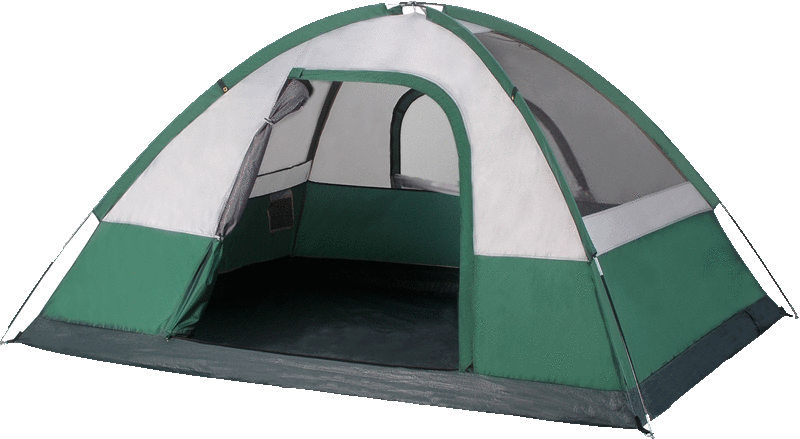
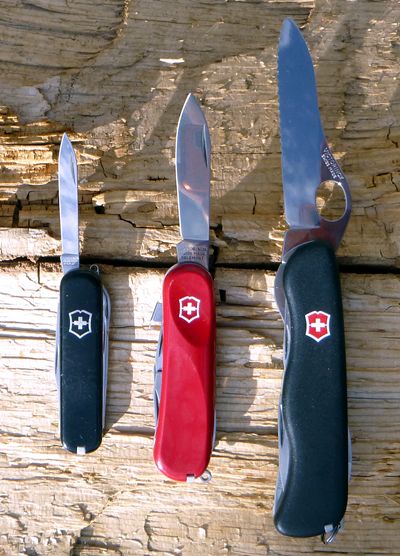
 .
.






